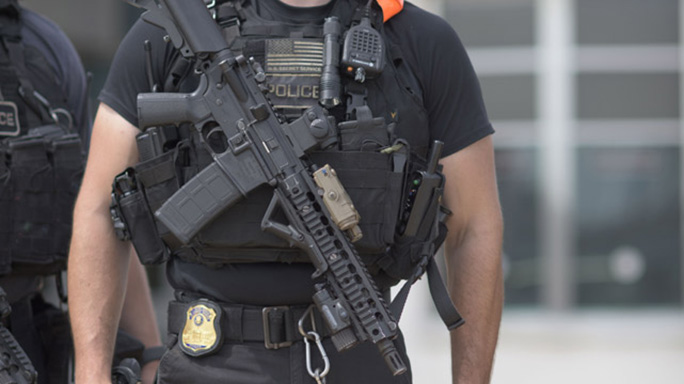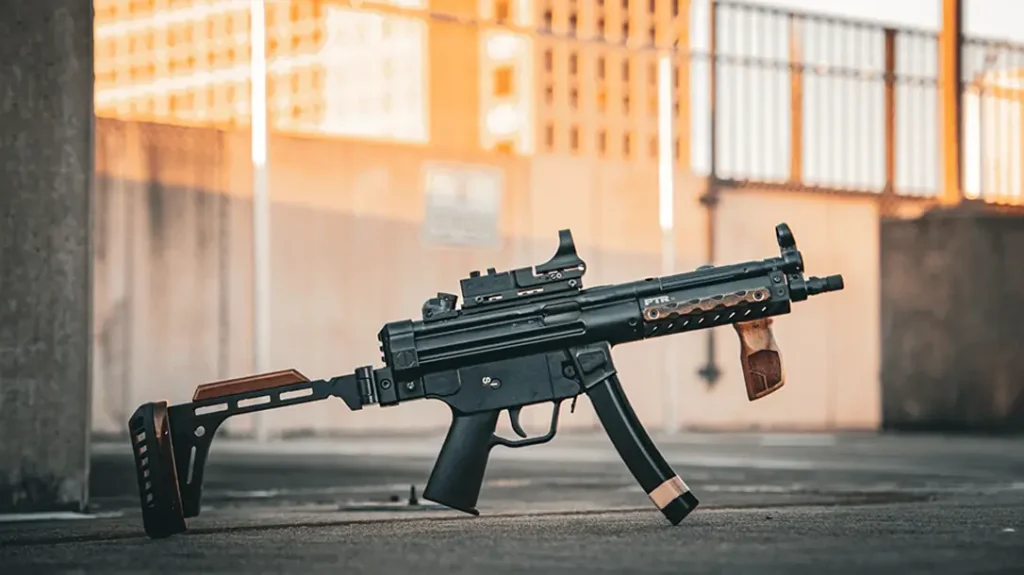The United States Secret Service is looking for a new 5.56x45mm rifle. Soldier Systems reports that the Secret Service has issued a pre-solicitation notice calling for an IDIQ (Indefinite-Delivery, Indefinite-Quantity) contract over a period of five years, with the award expected to be handed out in fiscal year 2018.
- RELATED STORY: 3 DHS Agencies That Rely on the Sig Sauer P229
The requirements for the new Secret Service rifle are many, but, essentially, they want an ambidextrous rifle with full- and semi-auto capability for use in all environmental conditions, including when “maximum concealment” is a must. All the external parts of the weapon should have a “dark subdued, rust/corrosion resistant finish” which is “unaffected by commercially available gun cleaning solvents, such as Simple Green, used in heated ultrasonic cleaning tanks.” Flaking, peeling and blotching of the finish won’t be accepted.
The Secret Service also says they’ll only use Magpul PMAGs and Mechanix Wear “Vent” gloves for testing.
Advertisement — Continue Reading Below
- RELATED STORY: 8 Law Enforcement-Ready AR-15 Rifles Under $1,000
Below is a snapshot of the official Draft Statement of Requirements detailing what the Secret Service looking for. You can read it in full at fbo.gov.
Dimensional Requirements
Height (no taller than, sights folded, w/o accessories or magazine) – 8.5 inches
Weight (no heavier than, w/o accessories) – 7.5 pounds
O/A Length (no longer than, w/stock fully extended) – 34 inches
Barrel length (min – max) – 10-12 inches
Rifling (5.56) – 1 turn 7” inch twist RHAdvertisement — Continue Reading Below
Operating System
The weapon shall utilize a direct-impingement gas-operated system or a short- stroke gas piston system.
Barrel
Advertisement — Continue Reading Below
The barrel shall have a minimum service life of 15,000 rounds.
Barrel service life is defined as a not exceeding 5 Minutes-of-Angle (MOA) and exhibiting no more than 125 ft/sec decrease in velocity (in accordance with USSS velocity testing procedures), with observance of offeror’s submitted maintenance protocols.
The barrel shall be free of cracks, seams, and other injurious defects and the bore and chamber shall be free of pockets, rings, bulges, and other deformations. The bore and chamber shall be chromium plated, or of equivalent corrosion resistance. Any coating in the chamber and bore shall be free of nodules, flaking, pits, stripping, anode burrs and evidence of etched base steel. Burrs and sharp edges shall be removed from the chamber edges, and bolt locking lugs.
Advertisement — Continue Reading Below
The muzzle of the barrel should bear a thread size of 1⁄2” x 28 tpi, with shoulder geometry of 90 degrees.
The muzzle should be equipped with a flash hider device, installed with shims as necessary.
Crush washers are not acceptable.
Advertisement — Continue Reading Below
Mode of Fire
The weapon shall be selective fire, i.e. semi-automatic and full automatic. A “burst limiter” in the full-automatic mode is not acceptable.
Fire Selector
Advertisement — Continue Reading Below
The fire control selector shall be ambidextrous in design, and be a single lever paddle mounted on the side of the receiver, adjacent to the rear pistol grip, thereby not requiring the shooter to significantly break their firing grip when actuating.
The fire control selector shall be a rotary type and shall have three positions; safe, semi- automatic and automatic and shall rotate manually without binding from one position to another when the hammer is cocked. The selector shall remain in place in each position by a perceptible spring detent load until manually reset.
Trigger
Advertisement — Continue Reading Below
The trigger shall hold the hammer in the cocked position until the trigger is pulled. After partial or complete trigger pull, the trigger shall return to its normal forward positions (cocked and uncocked) under spring action.
The trigger pull shall not measure less than 4.0 pounds, nor more than 6.5 pounds, regardless if the fire selector is set on semi or full-automatic fire.
The trigger configuration shall be two-stage with no adjustment screws or set screws.
Advertisement — Continue Reading Below
The trigger shall have a smooth face, cannot be wider than the trigger guard, and shall be the only control inside the area enclosed by the trigger guard. Any other controls (bolt catch/release, magazine/catch release, etc.) inside the area enclosed by the trigger guard are not acceptable.
While utilizing gloves, the trigger shall not pinch the trigger finger between the trigger and the side of the receiver or between the trigger and the inside bottom of the trigger guard (see Note 1). Any manipulation/modification to the trigger guard to meet this requirement is not acceptable.
Charging Handle
The charging handle shall be situated in the upper receiver. The charging handle shall not reciprocate with the bolt when the weapon is fired. The charging handle shall be capable of being operated with one hand while the shooters other hand is grasping the pistol grip or forend grip.
Bolt Hold-Open Device
The rifle shall be equipped with a magazine activated bolt hold open device. The bolt hold open device shall also be capable of being activated manually by the operator. When the bolt hold open device is activated by the magazine follower and the magazine is subsequently removed, the bolt shall remain in the rear or open position. When the bolt is in the rear or open position and a full magazine is inserted, the bolt shall remain in the rear or open position until the operator manually activates the bolt release. When the bolt catch is released, the bolt shall return to the battery position. Upon release, the bolt shall strip a round from the loaded magazine and load it into the chamber.
Magazine
The weapon magazine well shall be compatible with the standard NATO STANAG 30 round M16 series magazine (NSN 1005-01-561-7200) and the Magpul PMAG 30 AR/M4, 5.56×45 Magazine (NSN 1005-01-628-5106 and NSN 1005-01-615-5169).
Only the Magpul PMAG 30 AR/M4, 5.56×45 Magazine (NSN 1005-01-615-5169; Mfr Part # MAG556) will be acceptable for solicitation submission and subsequent testing.
Lower Receiver
The lower receiver shall have a permanently affixed plate, label, or laser- etching, displaying a QR code or barcode, readable via commercially-available optical reader. This code shall be embedded with information specific to the host firearm, including (but not limited to) make, model/variant, and unique serial number.
Upper Receiver
The weapon shall be equipped with a Mil-Std-1913 Picatinny attachment rail on the top of the receiver for mounting of optics, iron sights, lasers, etc.
Forend/Handguard
The weapon shall have a modular free-floating handguard assembly measuring no less than 9.0 inches of functional/configurable railspace (measured along the 6:00 o’clock position of the rail).
Pistol Grip
The rear pistol grip shall be securely attached to the lower portion of the receiver and shall not interfere with the operation of the selector lever. If applicable to the submission, vendor shall provide interchangeable rear pistol grip adapters (backstraps).
Butt-Stock
The butt stock shall be quickly adjustable for length of pull without the use of any tools. The butt stock shall have, at minimum total of four positions, including fully extended and fully collapsed.
Backup Sights
When utilized, the front/rear ‘backup’ sights shall be viewable through an Aimpoint Model T2 while mounted on a suitable optic-specific commercially available sight mount.
Sling Mount
The weapon shall be supplied with means to mount a sling to, at minimum, the rear area of the receiver and the handguard, via quick-detach sling swivel. All sling mounting/attachment points will be required to be rotation-limited (4-position) quick-detach cups, to allow interface with quick-detach push button swivels.
























